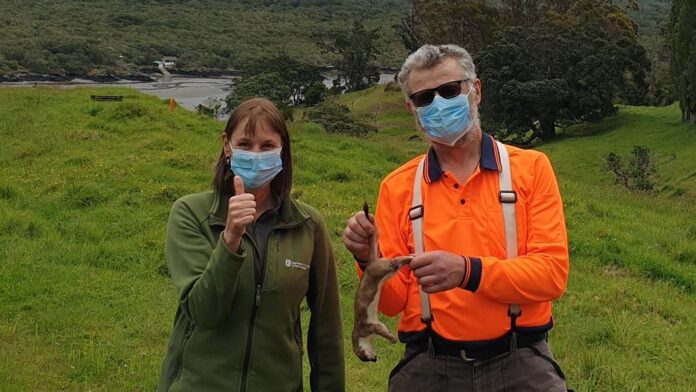Source: Department of Conservation
Date: 09 November 2021
Department of Conservation (DOC) Incident Control Manager Dave Smith says DOC and iwi have been hunting stoats on the island for over a year, in what has been a challenging and frustrating effort to stop the killer pests from undoing years of conservation work on the pest free island.
“We currently have a trap network of over 600 traps which have been added to over the last 12 months. We regularly bring conservation dogs onto the island to assist in the search, and last week a handler and her dog identified a new location of interest.
“There, we decided to try out a new trap lure. The new method delivered a great result.”
The stoat, confirmed to be a male, was found in a trap that was hidden in an artificial den, lured with a playback recording of baby stoats and female stoat-scented bedding. The sonic lure was introduced to the trapping toolkit recently and this is the first time DOC has captured a stoat using this method.
DOC Technical Advisor Stuart Cockburn says the method was an interesting approach to trapping stoats.
“Sound lures have often shown promise in trials, but this result shows that if the recipe is right, with the right sound combined with clever trap setting, this new technique can get the job done.”
Billy Brown, a representative for Ngai Tai ki Tāmaki, says the news is great leading into summer, and an excellent example of iwi and DOC’s, ‘mahi tahi’.
“Our team of trappers work in some of the most extreme conditions, especially on Peretū – Rangitoto, so I want to acknowledge their hard work and perseverance. The islands and the taonga species they nurture have one less challenge to contend with.
“We have had to utilise a wide range of expertise and skillsets while exploring initiatives outside of traditional trapping methods as this has been a particularly guileful stoat.”
Dave says the team are elated with the news, but the work isn’t over yet.
“There were definitely cheers of joy from our team working from home and those on the islands, but we still have more to do considering the potential of another stoat presence.
“This find is a huge booster and an exciting new development that we hope will help us find the other stoat.”
Stoat presence was first detected on both Motutapu and Rangitoto islands in May 2020. Since then, three stoats have been trapped: one in September 2020, another in January 2021, and now this third stoat on Friday.
A rāhui and incursion response remains in place, which involves servicing an extensive network of traps across Motutapu and Rangitoto. Conservation dogs and trail cameras will continue to assist with these efforts.
The stoat will be sent for a DNA analysis which includes sampling and stomach content testing.
Contact
For media enquiries contact:
Email: media@doc.govt.nz



